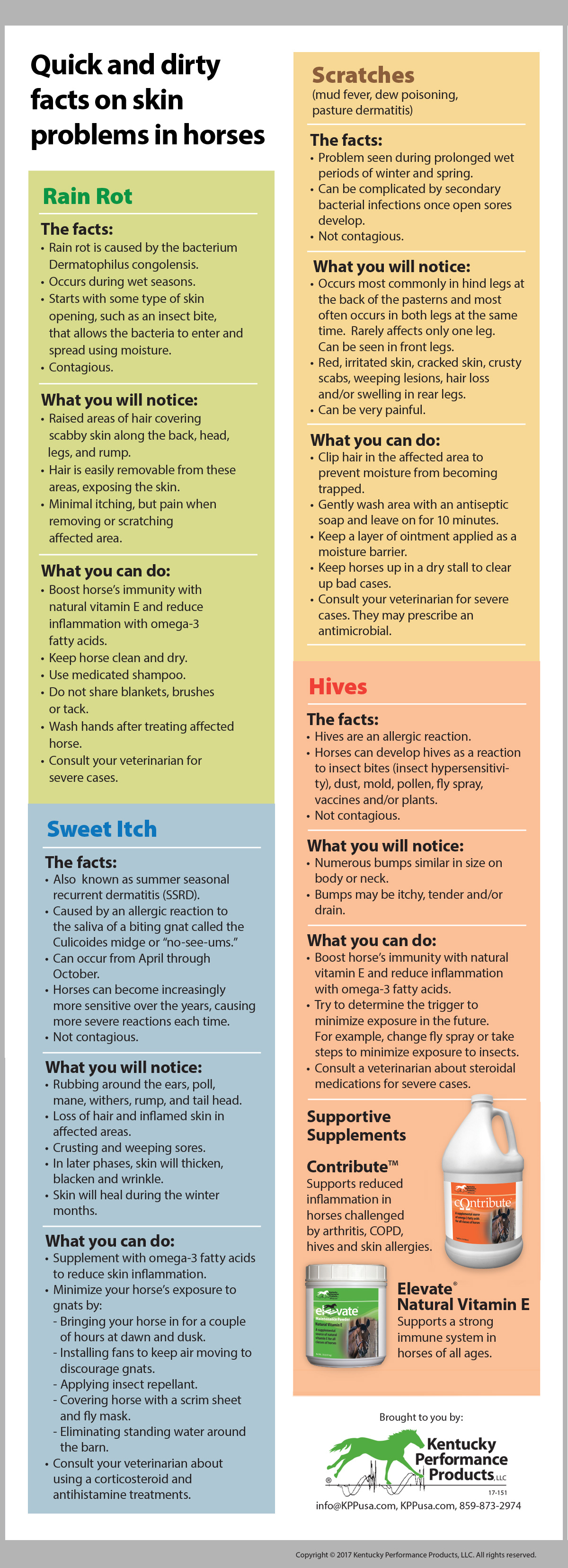Quick and Dirty Facts on Skin Problems in Horses

Click here to download a print version of this infographic.
Text-only version of “Quick and Dirty Facts on Skin Problems in Horses
Rain Rot
The facts:
- Rain rot is caused by the bacterium Dermatophilus congolensis.
- Occurs during wet seasons.
- Starts with some type of skin opening, such as an insect bite, that allows the bacteria to enter and spread using moisture.
- Contagious.
What you will notice:
- Raised areas of hair covering scabby skin along the back, head, legs, and rump.
- Hair is easily removable from these areas, exposing the skin.
- Minimal itching, but pain when removing or scratching affected area.
What you can do:
- Boost horse’s immunity with natural vitamin E and reduce inflammation with omega-3 fatty acids.
- Keep horse clean and dry.
- Use medicated shampoo.
- Do not share blankets, brushes or tack.
- Wash hands after treating affected horse.
- Consult your veterinarian for severe cases.
Sweet Itch
The facts:
- Also known as summer seasonal recurrent dermatitis (SSRD).
- Caused by an allergic reaction to the saliva of a biting gnat called the Culicoides midge or “no-see-ums.”
- Can occur from April through October.
- Horses can become increasingly more sensitive over the years, causing more severe reactions each time.
- Not contagious.
What you will notice:
- Rubbing around the ears, poll, mane, withers, rump, and tail head.
- Loss of hair and inflamed skin in affected areas.
- Crusting and weeping sores.
- In later phases, skin will thicken, blacken and wrinkle.
- Skin will heal during the winter months.
What you can do:
- Supplement with omega-3 fatty acids to reduce skin inflammation.
- Minimize your horse’s exposure to gnats by:
- Bringing your horse in for a couple of hours at dawn and dusk.
- Installing fans to keep air moving to discourage gnats.
- Applying insect repellant.
- Covering horse with a scrim sheet and fly mask.
- Eliminating standing water around the barn.
- Consult your veterinarian about using a corticosteroid and antihistamine treatments.
Scratches (mud fever, dew poisoning, pasture dermatitis)
The facts:
- Problem seen during prolonged wet periods of winter and spring.
- Can be complicated by secondary bacterial infections once open sores develop.
- Not contagious.
What you will notice:
- Occurs most commonly in hind legs at the back of the pasterns and most often occurs in both legs at the same time. Rarely affects only one leg. Can be seen in front legs.
- Red, irritated skin, cracked skin, crusty scabs, weeping lesions, hair loss and/or swelling in rear legs.
- Can be very painful.
What you can do:
- Clip hair in the affected area to prevent moisture from becoming trapped.
- Gently wash area with an antiseptic soap and leave on for 10 minutes.
- Keep a layer of ointment applied as a moisture barrier.
- Keep horses up in a dry stall to clear up bad cases.
- Consult your veterinarian for severe cases. They may prescribe an antimicrobial.
Hives
The facts:
- Hives are an allergic reaction.
- Horses can develop hives as a reaction to insect bites (insect hypersensitivity), dust, mold, pollen, fly spray, vaccines and/or plants.
- Not contagious.
What you will notice:
- Numerous bumps similar in size on body or neck.
- Bumps may be itchy, tender and/or drain.
What you can do:
- Boost horse’s immunity with natural vitamin E and reduce inflammation with omega-3 fatty acids.
- Try to determine the trigger to minimize exposure in the future. For example, change fly spray or take steps to minimize exposure to insects.
- Consult a veterinarian about steroidal medications for severe cases.
Supportive Supplements for skin problems in horses
Supports reduced inflammation in horses challenged by arthritis, COPD, hives and skin allergies.
Supports a strong immune system in


